- Tender Perennials and Tropical Plants
- Essentials of Container Gardening
- Selecting Containers
- Designing with Plants
- Working with Shape, Texture and Color
- Plant Positions in the Container
- Where to Place Containers
- Fertilizing Tropical Plants in Containers
- Theme Gardens
- Plant Maintenance
- Container Recipes
- Table 1: Selected Commonly Marketed Tropical Plants
Container gardening has enjoyed an increased popularity in the last decade. With increased urbanization, container gardens have come to the rescue to brighten up patios and balconies. A great many plants have been used in container gardens — from herbaceous annuals, bulbs, succulents and perennials to woody Japanese maples and conifers.
Tender Perennials and Tropical Plants
Particularly in the South, high heat and humidity often combined with drought, present a serious challenge to ornamental gardening. This can be especially true for container gardens, where plant roots have limited soil space to access water and nutrients. Large day-to-day fluctuations in soil moisture and nutrients occur in the enclosed container space. Optimal growth and flowering can be adversely affected. Select plants carefully, with consideration as to whether the plants can not only withstand these conditions but perform satisfactorily under them. In addition, it is a good idea to include plants with significant foliar interest, to supplement flowering materials that may not be at their best throughout the season.
Many plants considered tender perennials and tropicals hold up very well in the challenging conditions and can tolerate extremes of heat, humidity, and moisture. Some are uniquely adapted to low-light environments and can be used in containers suited for shaded areas. These plants are traditionally used as interiorscape plants, but they have shown much potential for outdoor use in the summer as well. Others can tolerate or even thrive in full sun.
Because most interiorscape plants are selected for their attractive foliage, the mixed garden will permanently exhibit interest.
This publication is intended to provide information on successful gardening in containers using tropical plant materials.
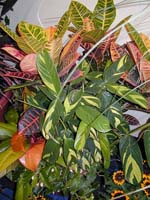 Figure 1a. Colorful combination gardens made up exclusively of tropical foliage plants. This container features high-light adapted plants and can be used on patios, sundecks, around pools, etc.
Figure 1a. Colorful combination gardens made up exclusively of tropical foliage plants. This container features high-light adapted plants and can be used on patios, sundecks, around pools, etc.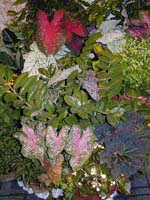 Figure 1b. Colorful combination gardens made up exclusively of tropical foliage plants. This container uses plants best adapted for low-light environments.
Figure 1b. Colorful combination gardens made up exclusively of tropical foliage plants. This container uses plants best adapted for low-light environments.
Essentials of Container Gardening
Selecting Containers
Because of the great variety of options, choosing containers can be challenging but enjoyable! The price range can be wide, especially for large, terracotta glazed containers, which usually are most expensive. Many people choose plastic containers, which are less expensive. These can be just as attractive as heavy clay pots and not as liable to breakage. You can select moss or coco fiber baskets or plastic baskets. Both work equally well as far as plant performance is concerned.
The style and shape of the container should complement the plants grown. The style and shape also should complement other containers for best display. The size of the container will limit the size of the plant. A wide range of materials is available — plastics, fiberglass, terra cotta, stone and wood.
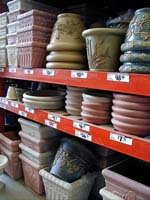 Figure 2a. Containers
Figure 2a. Containers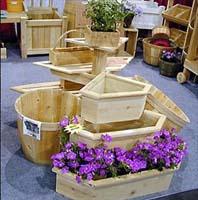 Figure 2b. Containers
Figure 2b. Containers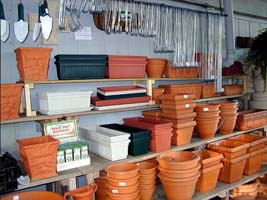 Figure 2c. Containers
Figure 2c. Containers
Make sure that used containers are clean. Wash out any old compost, chemical or paint residues. To help prolong the life of wooden containers, line them with plastic. The type of plants will determine the growing conditions you will need to create.
Unless you are creating a bog garden, the container must have drainage holes. If not, the compost will become saturated and stagnant, killing the plants. A 3- to 5-gallon container should have at least four drainage holes. Containers made of molded foam usually do not come with pre-drilled holes, so you must add them. There’s usually a reminder from the manufacturer so you won’t forget.
Here are a few things to keep in mind when selecting baskets. Moss lining looks natural and allows easy planting through the base and sides of the basket. You can use a black plastic (polyethelene) liner inside the moss liner if holes are pierced through. This helps hold moisture while retaining a “natural” effect. Coconut-fiber matting liners are a woolly-textured, natural-looking fiber that lasts several seasons.
Biodegradeable liners are made from compressed fibers, and will last for 2 years or more. Holes need to be made in sides and base for trailing plants. Plastic, when used alone with pierced holes, is an effective container but it only looks good if plants grow over to camouflage the container.
Soils for containers need to have three key elements: (1) drainage, (2) aeration and (3) water retention. If you use moss, coco fiber baskets or any container that allows high evaporation, consider adding a water-retaining agent to the soil mix. Mix a moisture-retaining agent in the medium (follow manufacturer’s recommendation for mixing rates) or purchase a soilless medium premixed with a moisture retaining agent.
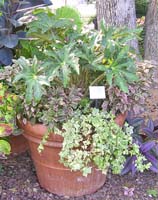 Figure 3.
Figure 3.Designing with Plants
When planning a container garden, you should follow some basic design principles.
The first design principle is focus. You need to draw the eye toward the center of the container and let the other plants complement and “flow” around this center. In Figure 3, the visually strong Begonia foliage serves that purpose.
The second design principle is balance. This may be accomplished using symmetrical or asymmetrical design. In symmetrical designs, there is an equal amount of plant material on all sides. In the container shown in Figure 3, the vertical begonia pulls the eye to the top right, while the trailing ivy draws the eye to the bottom left creating an asymmetrical effect. In either case balanced design is achieved.
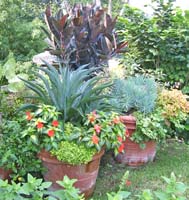 Figure 4.
Figure 4.Form is the third design principle. Each plant in the design has a growth habit, or form. Some plants have a strong upright habit. Others have a sprawling habit, while a third type grows as a mound. Each of these habits can contribute to the overall aesthetic quality of the container garden if used in the right place. In the example in Figure 4, the Elephant ear (Alocasia) gives the design height, the Coleus and New Guinea Impatiens show a mounded habit, and the Ivy drapes over the container’s edge.
A fourth design principle is texture. Various plants have different textured foliage. Some have linear leaves, like grasses, Dracaena or Cordyline. Others have rounded leaves, like the Elephant ear, Begonia, Philodendron and Coleus. A good design will use a variety of textures to make “a feast for the eye.”
A fifth design principle is rhythm. Rhythm is achieved by planting the same or similar-looking plants at repeated intervals. When the eye travels around the container, the viewer gets a sense of a rhythmic movement.
A sixth design principle is proportion. To keep plants and container in proportion and achieve a balanced appearance, the height of the plants should not exceed three times the height of the container. For shallow or small containers, choose plants that will not get too large and/or choose plants with small-sized foliage. For large or tall containers, choose medium to large plants and/or plants with large leaves.
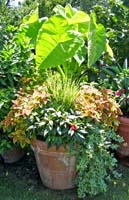 Figure 5.
Figure 5.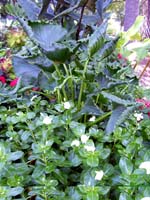 Figure 6.
Figure 6.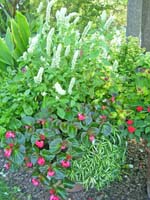 Figure 7.
Figure 7.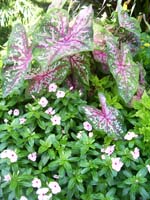 Figure 8.
Figure 8.
Working with Shape, Texture, and Color
Along with the tropical foliage plants, you can use flowering annuals such as Vinca, Wax Begonia, Ivy Geranium, Bacopa, Calibrachoa, Torenia, New Guinea Impatiens, regular Impatiens, Verbena, Portulaca and Lantana.
Caladium cultivars are available in a great variety of foliage colors, shapes and sizes. They can also help “echo” the color of flowers in the container.
Tropical plants boast a wonderful variety of foliage textures and colors. Mix plants with at least three textures of foliage to make a container garden interesting (Figure 9).
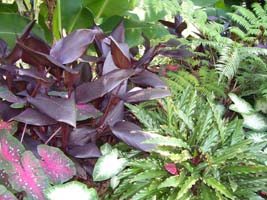 Figure 9a. Ginger, Calathea, Caladium, Fern
Figure 9a. Ginger, Calathea, Caladium, Fern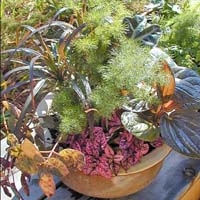 Figure 9b. Dracaena, Asparagus, Hypoestes, Peperomia
Figure 9b. Dracaena, Asparagus, Hypoestes, Peperomia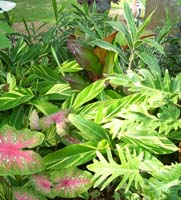 Figure 9c. Alpinia, Setaria, Canna, Philodendron, Caladium
Figure 9c. Alpinia, Setaria, Canna, Philodendron, Caladium
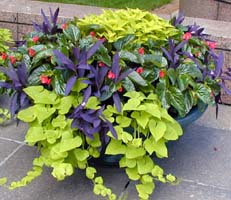 Figure 10.
Figure 10.Some good foliage contrasts include downy with glossy, small with large, and yellow or lime-green with purple. Some of those in Figure 10: the glossy Begonia ‘Dragon Wing’ against the matte leaves of Setcresea and the chartreuse of Ipomoea ‘Marguerite’ with the purple of Setcresea.
Plant Positions in the Container
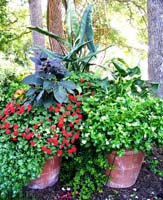 Figure 11.
Figure 11.Figure 11 shows an arrangement of plants.
Center plants provide compact, upright growth to fill in the crown of the container. Examples are Elephant Ears (Alocasia, Colocasia), Dracaena, Cordyline, palms.
Filler plants typically have compact, upright growth and round out the top of the container. Examples are Cuphea, Coffee, Ctenanthe, gingers, Graptopetalum.
Corner plants grow well over the container’s edge and benefit from a corner position where they have maximum elbowroom. Examples are: Begonia, Alternantera, bromeliads, Fittonia, Pillea, Peperomia.
Edge plants drape over the side, softening the look of the container and filling out the space between its corners. Examples are Ivy, String of pearls, Hoya, Tradescantia, Selaginella.
Refer to Table 1 for a list of plants, their characteristics and intended use in a container garden.
In a successful container garden all plants combined in one container must have similar water, light and fertilizer requirements.
Where to Place Containers
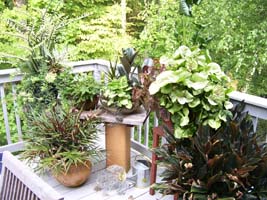 Figure 12.
Figure 12.When choosing a location for your container garden, avoid exposed windy sites. (Figure 12) Plants in windy locations use a large amount of water in order to survive. Windy, hot, conditions may require watering every few hours, especially if the plants are large, and/or the container is small.
For locations that receive 4-12 hours of sun a day, select full sun to part shade plants. For locations that receive 2-4 hours of sun daily, select plants for part or full shade. Many tropical plants have flexible light requirements and will grow well in shade, although flowering may be reduced. If using shade requiring plants listed in Table 1, you may include them in the side of the container that will not be exposed to direct sun. This way they will not burn, yet they will receive ample light for good growth.
Fertilizing Tropical Plants in Containers
For best results with tropical plants, regular fertilization should be done with a combination of liquid feed and a slow-release fertilizer. You can apply slow-release fertilizer at planting, mixed in the soil or top-dress, or use a soilless mix with slow-release fertilizer incorporated in. Depending on the duration of the slow-release fertilizer formulation, you may have to make several applications. Follow label directions when applying fertilizers.
Theme Gardens
You may also create a theme garden, such as a fern garden (Figure 13), or a succulent garden (Figure 14). Theme gardens usually combine plant species that are either closely related, such as ferns, or belong to a category, such as cacti and succulents. Since the plants included in a theme usually have similar light, moisture, and nutrient requirements, these gardens are easy to care for.
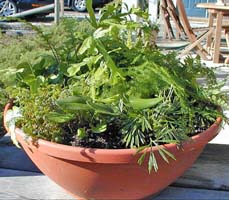 Figure 13.
Figure 13.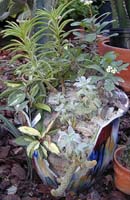 Figure 14.
Figure 14.
Plant Maintenance
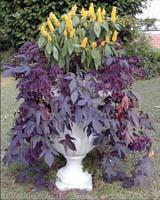 Figure 15.
Figure 15.Nothing lasts forever! Container gardens need to be gardened. (Figure 15)
Most plants benefit from pinching, which is the removal of young tissue located at the tips. This encourages branching and fuller growth. Later in the season, trimming may be needed in order to rejuvenate the plant.
Spraying for pests and diseases may be needed; usually insecticidal soap and/or insecticidal oil are sufficient in holding the pests in check.
Remove weeds by hand.
Container Recipes
The following container gardens were created and maintained at the Research and Education Garden at the University of Georgia Campus in Griffin, Georgia. The containers used were 36-inch or larger in diameter, made of foam or plastic. They were planted in late April or early May in bark-based commercial mix, supplemented with a slow-release fertilizer and a water-retention agent.
Combinations for Sun/Part Shade
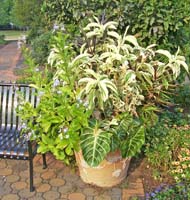 Costus 'Variegatus'
Costus 'Variegatus'Alocasia
Cordyline 'Purple Knight'
Clerodendron ugandense
Hedychium
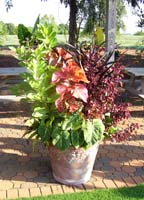 Alocasia sinuata
Alocasia sinuataAnthericum saundersiae 'St. Bernard's Lily'
Philodendron gloriosum
Syngonium 'Williamsii'
Micania
Caladium 'Brandywine'
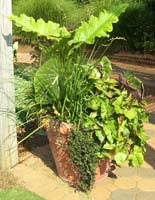 Colocasia 'Purple Stem'
Colocasia 'Purple Stem'Cordyline 'Red Star'
Iresine 'Curly'
Talinum 'Jewels of Opar'
Begonia 'Benitochiba'
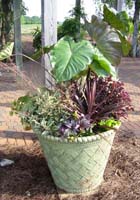 Canna 'Purpurea'
Canna 'Purpurea'Begonia 'Benitochiba'
Euphorbia 'Burrows Silver'
Rhoeo bermudensis
Iresine formosa
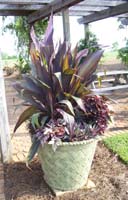 Clerodendron ugandense
Clerodendron ugandenseCordyline 'Rosa'
Iresine 'Curly'
Acalypha wilkesiana
Anthurium crystallinum
Caladium 'Red Ruffles'
Syngonium 'Christmas'
Combinations for Shade
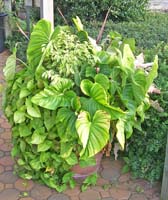 Caladium 'Pink Symphony'
Caladium 'Pink Symphony'Philodendron gloriosum
Syngonium 'Confetti'
Ficus benjamina
Begonia 'Black Beauty'
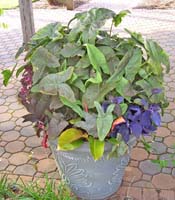 Philodendron gloriosum
Philodendron gloriosumAnthurium crystallinum
Zinzibar 'Midnight'
Xanthosoma 'Magnificum'
Polypodium
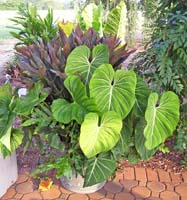 Alocasia 'Excalibur'
Alocasia 'Excalibur'Syngonium 'Neon'
Setcresea
Philodendron 'Prince of Orange'
Iresine 'Curly'
Begonia 'Cherries & Chocolates'
Status and Revision History
Published on Feb 03, 2008
Published on Nov 01, 2010
Published with Full Review on Feb 01, 2014
Published with Full Review on Mar 28, 2017
Published with Full Review on May 27, 2020
Published with Full Review on Jul 21, 2022


























































